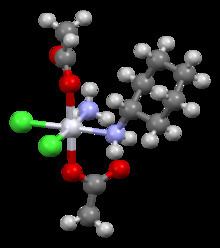Routes ofadministration Oral CAS Number 129580-63-8 UNII 8D7B37T28G | ATC code L01XA04 (WHO) PubChem CID 123974 Molar mass 500.277 g/mol | |
 | ||
Synonyms BMY 45594BMS 182751(OC-6-43)-bis(acetato)amminedichlorocyclohexylamine platinum(IV) | ||
Satraplatin (INN, codenamed JM216) is a platinum-based antineoplastic agent that is under investigation as one treatment of patients with advanced prostate cancer who have failed previous chemotherapy. It has not yet received approval from the U.S. Food and Drug Administration. First mentioned in the medical literature in 1993, satraplatin is the first orally active platinum-based chemotherapeutic drug; other available platinum analogues—cisplatin, carboplatin, and oxaliplatin—must be given intravenously.
Contents
It is made available in the United States jointly by Spectrum Pharmaceuticals and GPC Biotech under the name SPERA (SatraPlatin Expanded Rapid Access).
The drug has also been used in the treatment of lung and ovarian cancers. The proposed mode of action is that the compound binds to the DNA of cancer cells rendering them incapable of dividing.
Medical Use
Satraplatin is an orally bioavailable platinum chemotherapeutic agent under development for several cancer types, including hormone-refractory prostate cancer (HRPC). Satraplatin is being developed for the treatment of men with chemorefractory HRPC for several reasons. It's relative ease of administration, potential lack of cross-resistance with other platinum agents, clinical benefits seen in early studies of HRPC, and an unmet need in this patient population after Docetaxel failure. Satraplatin may provide a palliative benefit for patients in terms of progression-free survival according to the most recent analyses of the phase III SPARC trial, and is currently under Food and Drug Administration review for this indication. Whether satraplatin and prednisone offer an advantage over docetaxel retreatment or other cytotoxic agents in this setting is under investigation.
Satraplatin has a favorable toxicity profile, and appears to have clinical activity against a variety of malignancies such as Breast Cancer, Prostate cancer and Lung cancer. The oral route of administration and the intermittent schedule makes it very convenient for clinical use. Despite this, a FDA-approved indication has not yet been achieved. The only Phase III trial with satraplatin was conducted in pre-treated metastatic prostate cancer(CRPC), revealing an improvement in progression-free survival but no overall survival benefit.
Side Effects
Anemia, diarrhea, constipation, nausea or vomiting, increase risk of infection, bruising.
Possible Risks and Complications
History
Platinum-based chemotherapy was an accidental discovery in the laboratory by Barnett Rosenberg. Rosenberg noticed inhibited cell division of Escherichia coli cells during electrolysis of a platinum-based electrode. The compound discovered was later named Cisplatin and clinically used by 1970. After years of use, cisplatin became an invaluable component of therapy for some common cancer tumors such as lung, head, neck, and bladder cancers. Kidney damage, neurotoxicity, ototoxicity, development of resistance were some of the more serious side effects that prompted the development of novel platinum analogues.
In 1982 Carboplatin was found to be a popular platinum-based compound very similar to cisplatin. After many trials and analyses with successful results equivalent to those of cisplatin but with a more tolerable toxicity profile making the drug more desirable for therapy. The more serious side effects that were associated with carboplatin were bone marrow suppression and principally thrombocytopenia. Carboplatin was approved by the FDA in 1989 to be used to treat advanced Ovarian cancer.
Research found that Oxaliplatin was demonstrating successful activity in patients with advanced colon cancer. Studies done in 2000 to 2004 supported the utility of oxaliplatin in combination with chemotherapy. The use of oxaliplatin in combination with Fluorouracil and Folinic acid was approved by the FDA for the treatment of only stage IV Colorectal cancer then later approved for stage III colon cancer patients who had previously received complete resection of the primary tumor. Many human tumors including testicular, bladder, lung, head, neck, and cervical cancers have been treated with platinum compounds. All of the marketed platinum analogues must be administered via intravenous infusion is one of the main disadvantages for these platinum compounds due to severe, dose limiting effects. An acquired resistance to cisplatin/carboplatin in ovarian cancer was discovered due to insufficient amounts of platinum reaching the target DNA or failure to achieve cell death. These drawbacks led to the development of the next generation of platinum analogues such as satraplatin
Mechanism of Action
Satraplatin is a prodrug, meaning it’s metabolized in the body and transforming into its working form. The two polar acetate groups on satraplatin increase the drugs bioavailability, which in turn allows for a large fraction of the administered dose to make it into the bloodstream where metabolism begins. Once the molecule makes it to the bloodstream the drug loses its acetate groups. At this point the drug is structurally similar to cisplatin with the exception of one cyclohexylamine group in place of an amine group. Since the drug is now structurally similar to cisplatin it’s mechanism of action is also very similar. The chlorine atoms are displaced and the platinum atom in the drug binds to guanine residues in DNA. This unfortunately happens to not only cancer cells but other regular functioning cells as well causing some of the harsh side effects. By binding to guanine residues satraplatin inhibits DNA replication and transcription which leads to subsequent apoptosis. Where satraplatin differs is its cyclohexamine group. In cisplatin the two amine groups are symmetrical while satraplatin's cyclohexamine makes it asymmetrical which contributes to some of the drug's special properties.
A large problem with cisplatin and other platinum based anti-cancer drugs is that the body can develop resistance to them. A major way that this happens is through a mammalian nucleotide excision repair pathway which repairs damaged DNA. However, some studies show that satraplatin compared to other platinum anti-cancer drugs can be elusive and are not recognized by the DNA repair proteins due to the different adducts on the molecule (cyclohexamine). Since satraplatin is not recognized by the DNA repair proteins the DNA remains damaged, the DNA cannot be replicated, the cell dies, and the problem of resistance is solved.
